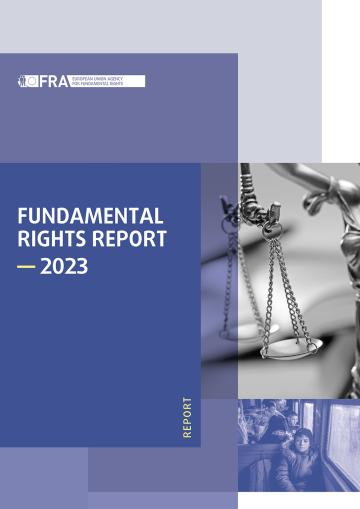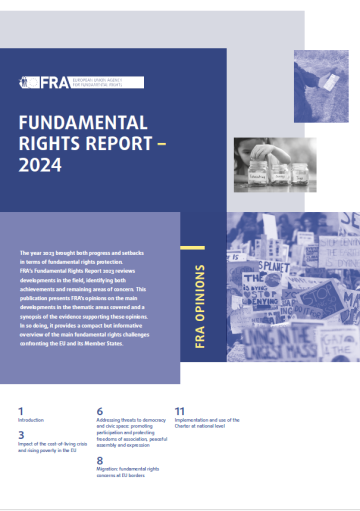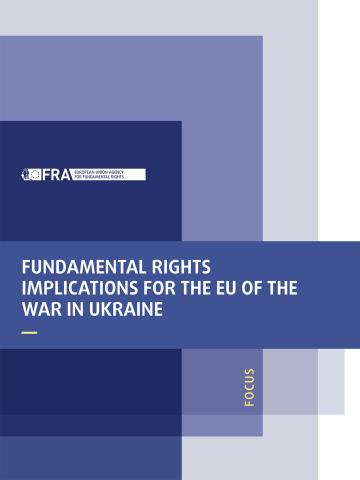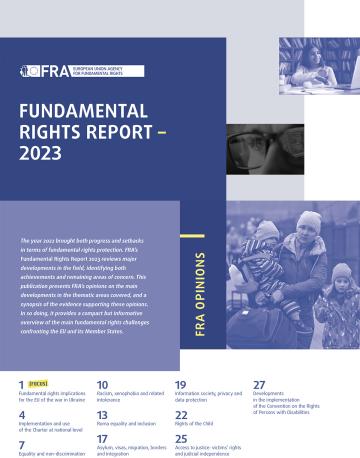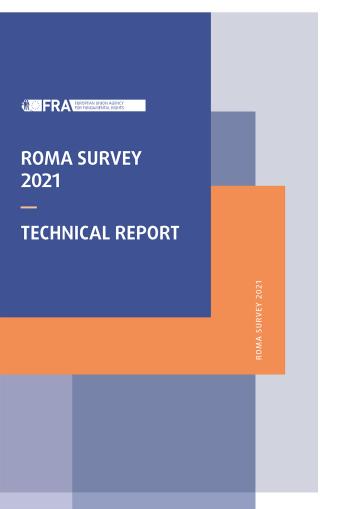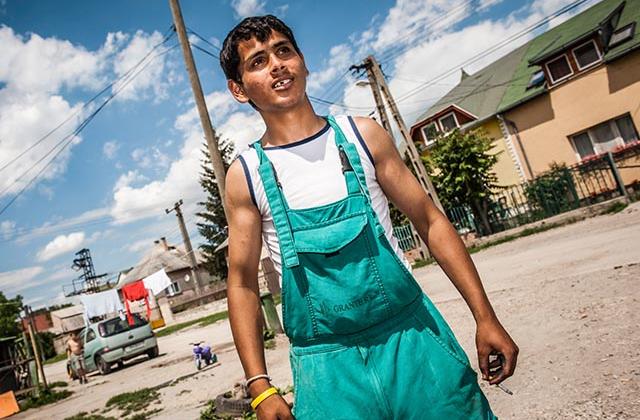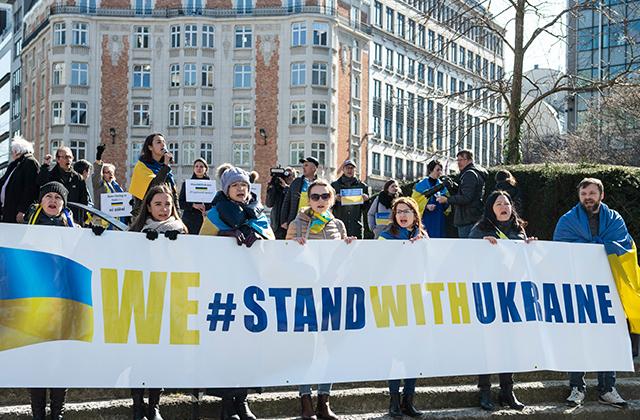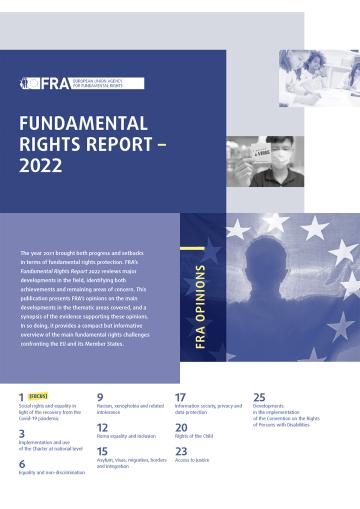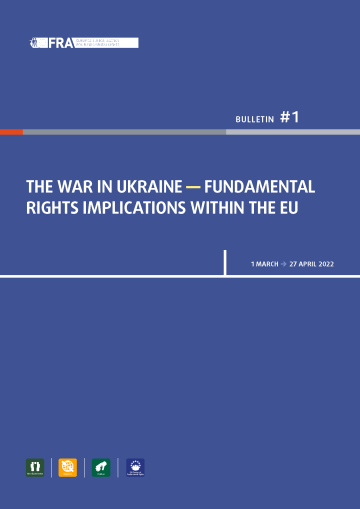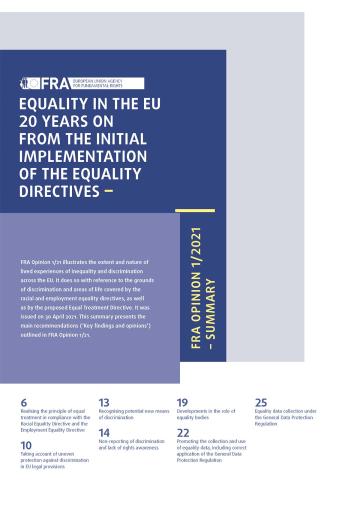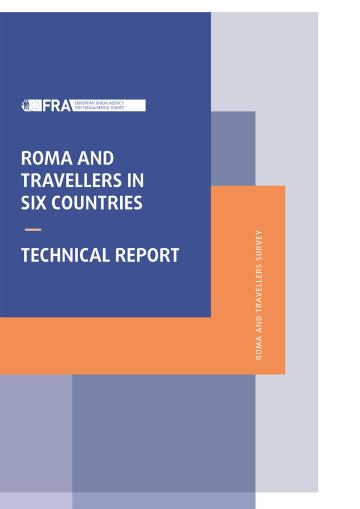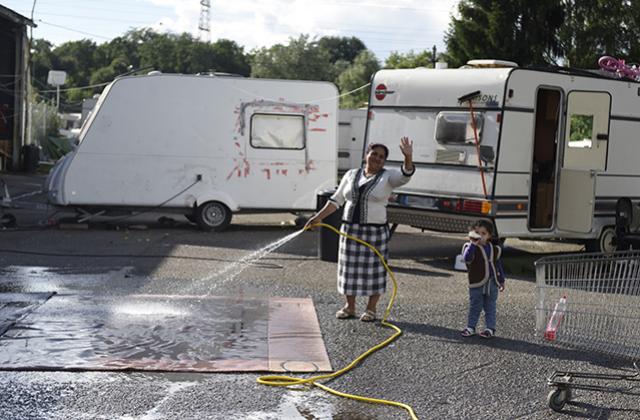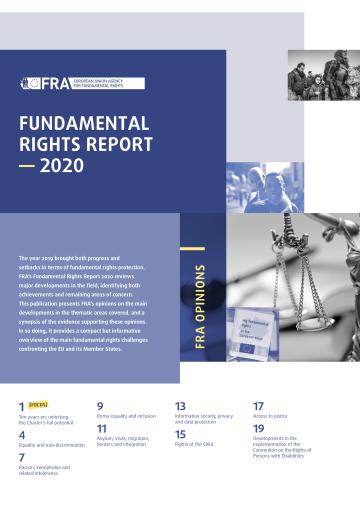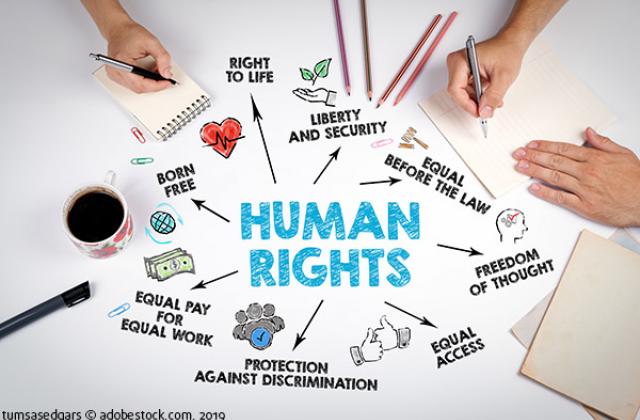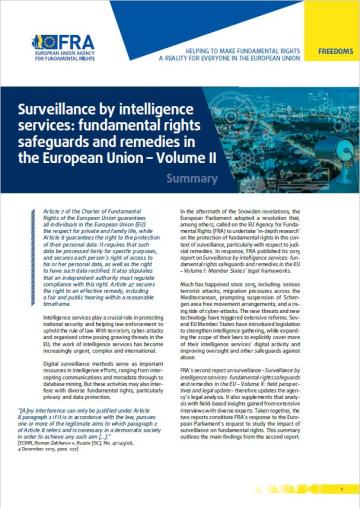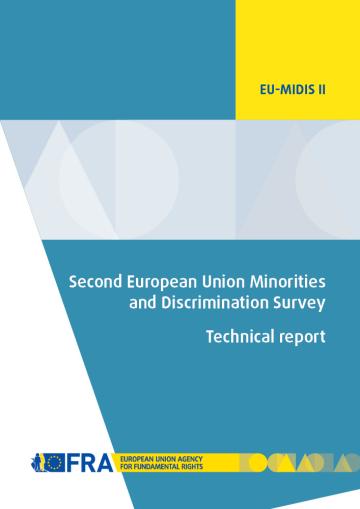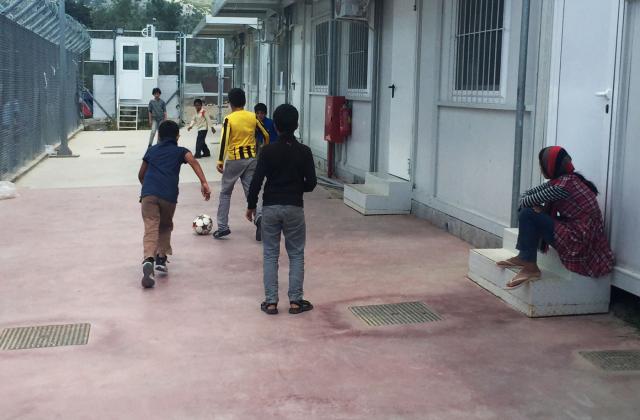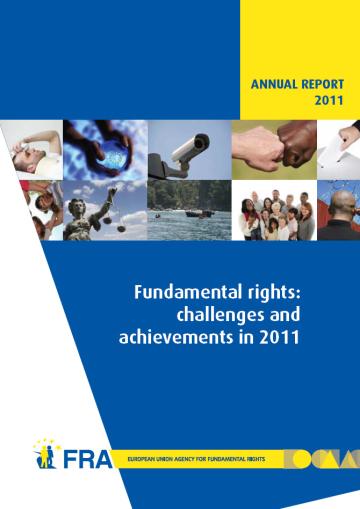This year's focus chapter looks at the fundamental rights implications for the EU of the war in Ukraine. It identifies challenges and propose solutions for all aspects covered by the Temporary Protection Directive and by EU laws on human trafficking, on hate crime and on the rights of crime victims, all of which apply to beneficiaries of temporary protection.
The remaining chapters cover: the EU Charter of Fundamental Rights; equality and non-discrimination; racism, xenophobia and related intolerance; Roma equality and inclusion; asylum, borders and migration; information society, privacy and data protection; rights of the child; access to justice; and the implementation of the Convention on the Rights of Persons with Disabilities.
- Fundamental rights implications for the EU of the war in Ukraine
-
Russia’s unprovoked war of aggression against Ukraine has resulted in massive internal and external population displacement. Nearly 8 million people fleeing Ukraine have arrived in Europe. Of these, nearly 4 million have received temporary protection in the EU. This displacement triggered a tremendous wave of support and solidarity from governments, local authorities and society as a whole. The EU activated the Temporary Protection Directive for the first time since its adoption in 2001. In the event of mass influx and unavailability of return, it entitles those displaced because of the war to legal residence and access to work, housing, social assistance, education and healthcare. As the overwhelming majority of those fleeing Ukraine are women – many with responsibilities for caring for children and/or older people – the provision of access to specific services needs to be gender sensitive and targeted. Services also need to include support for those who have experienced sexual violence and exploitation. The EU Agency for Fundamental Rights (FRA) launched a series of activities to identify challenges and propose solutions for all aspects covered by the Temporary Protection Directive and by EU laws on human trafficking, on hate crime and on the rights of crime victims, all of which apply to beneficiaries of temporary protection.
In this chapter:
- Legal and policy developments
- Fundamental rights situation and risks upon arrival
- Providing support with housing, access to the labour market, healthcare and education
- Addressing further challenges related to the arrival of displaced people
- Implementation and use of the Charter at national level
-
The 2020–2030 EU Charter strategy and the related 2021 Council conclusions remain the key documents guiding relevant action at both EU and national levels. At national level, court proceedings continued to refer to the Charter and, sometimes, so did legislative procedures. Otherwise, however, the use of the Charter remains limited. Examples of Charter-focused policies in national, regional and local administrations remain hard to find. The use of EU funds is an exception. The Common Provisions Regulation makes the obligation to observe the Charter very explicit. Another prominent Charter element at national level relates to the newly appointed Charter focal points in national administrations. National human rights institutions in selected Member States provided expert input on the Charter in legislative, administrative or judicial proceedings. However, national human rights institutions and civil society still lack capacity or awareness to use the Charter more actively in their work. The need for continued judicial training on the Charter appears to be increasingly recognised, and the European Commission funds it.
In this chapter:
- Introduction: the charter at EU level
- Application of the Charter by the Member States
- The role of civil society organisations, rights defenders and justice practitioners
- Strengthening awareness of Charter rights
- Equality and non-discrimination
-
The adoption of the Equal Treatment Directive remains stalled since 2008. The legal framework on hate crime and hate speech still does not provide sufficient protection for lesbian, gay, bisexual, transgender and intersex (LGBTI) people. In 2022 the European Commission proposed legislation aimed at strengthening the mandate and independence of equality bodies. Efforts to promote the rights of lesbian, gay, bisexual, trans, non-binary, intersex and queer (LGBTIQ) people were made at EU and national levels, in particular regarding family status and parenthood. There have been some developments across the EU to cover additional grounds of discrimination, such as socioeconomic status, health status and physical appearance.
In this chapter:
- EU continues to promote equality and non-discrimination
- Rights of LGBTIQ people
- Discrimination on the grounds of socio-economic status, health status and physical appearance
- Racism, xenophobia and related intolerance
-
Discrimination based on racial or ethnic origin, bias-motivated crimes and racist speech remained widespread in 2022. Evidence shows indications of systemic racism, including within law enforcement. Russia’s aggression against Ukraine led to emerging instances of hate speech and violent attacks in some EU Member States.
The European Commission continued infringement procedures against 12 Member States for not fully or accurately incorporating the Framework Decision on Racism and Xenophobia into national law. At the same time, several Member States amended their legislation to criminalise hate crime and hate speech. The European Parliament also urged Member States to ensure the full implementation and effective monitoring of the Racial Equality Directive.
The European Commission called on Member States to adopt national anti-racism action plans by the end of 2022, as the EU Anti-racism Action Plan and the EU Strategy on Combating Antisemitism and Fostering Jewish Life envisage. Only about half of them did so. Some Member States made targeted efforts to facilitate the reporting of racist incidents; they strengthened victims’ access to support, protection and justice.In this chapter:
- Racist crimes and hate speech widespread – racism at individual and systemic levels
- Systemic racism
- Implementing the EU legal framework against racism, xenophobia, antisemitism and related intolerance
- National policies and targeted measures to tackle racism, antisemitism and xenophobia, extremism and hate crime
- Roma Equality and Inclusion
-
By 2022, most EU Member States developed action plans and started implementing their national strategic frameworks to meet the 2030 targets of the EU Roma strategic framework for equality, inclusion and participation. In the course of the year, most Member States also drafted the national action plans for the effective implementation of the child guarantee, in which several Member States focus on strengthening education and inclusion of Roma children. FRA presented the results of the Roma survey conducted in 2021. Its findings show very little or no progress since the last survey in 2016 in fighting antigypsyism, and in equal access to education, employment, housing and health. The fundamental rights of Roma and Travellers were still not fully respected in 2022. Antigypsyism, discrimination, poverty and social exclusion, as well as hate crime and hate speech, continue to affect a disproportionate number of Roma and Travellers across the EU. Fatal incidents of police violence with Roma victims in 2022 indicate that institutional racism in law enforcement needs to be tackled.
In this chapter:
- Monitoring progress on Roma equality, inclusion and participation
- Implementing the EU Roma strategic framework
- Challenges and ways forward in the Member States
- Asylum, borders, visas, migration and integration
-
The onset of the Russian war of aggression against Ukraine resulted in the registration of nearly 4 million displaced people
across the EU, as the focus chapter of this report describes. At the same time, increased global mobility after the COVID-19 pandemic led to an increase in irregular border crossings into the EU.
Serious and persistent rights violations have been reported at several points along the EU’s external border. Combined with the lack of prompt and effective investigations, they pose serious challenges to the rule of law. Fundamental rights violations at borders worsened and impunity for unlawful action continues as violations are unaddressed.
Pressure on civil society organisations from state authorities and other actors defending migrants’ and refugees’ rights at borders is increasing. EU rules to reform asylum policies remain pending with the EU co-legislator. The mechanism to oversee the application of Schengen rules is being revised, with more attention given to fundamental rights. The legal instruments establishing information technology systems in the area of freedom, security and justice contain several fundamental rights safeguards; now the main challenge is to apply them in practice.In this chapter:
- Fundamental rights at borders
- Asylum and immigration policies in transition
- EU information technology systems
- Information society, privacy and data protection
-
From the use of artificial intelligence (AI) to online content moderation, retention of data, facial recognition technologies,
and access to/use of electronic evidence in criminal investigations, 2022 continued to pose a recurring question. How
can we best use all the available data to their fullest potential while complying with data protection and other fundamental
rights safeguards?
Discussions on the appropriate safeguards for the many uses of AI intensified at EU level. Increasing attention was paid to
fundamental rights.
Both international institutions and national governments debated how much police and judicial authorities may access
personal data. Initiatives authorising the use of modern surveillance technologies and access to data for security
purposes intensified. In parallel, so did related concerns of courts, civil society organisations and public authorities.In this chapter:
- Regulating AI and digital services from a fundamental rights perspective
- Judicial and law enforcement authorities’ access to data: a challenge for data protection safeguards
- Rights of the child
-
The number of children at risk of poverty and social exclusion continued to increase in 2022. High energy costs and rising
inflation placed additional burdens on the households in which families with children are struggling to cover basic needs. EU
Member States are trying to address the needs of children and families who are struggling, including through the European Child Guarantee.
Alongside the arrival of children fleeing Ukraine, the arrival of other non-EU asylum-seeking children continued to increase. As a result, several Member States struggled to provide basic reception conditions, and some continued to detain children in
the migration context. The European Commission issued several legislative proposals on victims’ rights. Member States have thus taken numerous legislative steps in the protection of children involved in justice systems as victims, as witnesses or when in conflict with the law.In this chapter:
- Child poverty: COVID-19-induced increase continues despite attention in European Union policies
- Protection of migrant and asylum-seeking children: a persistent challenge
- New legislative initiatives to ensure the protection of children during judicial proceeding
- Access to justice – victims’ rights and judicial independence
-
In 2022, there was some improvement in the area of victims’ rights, particularly concerning the protection of victims with specific needs.
Significant legislative and policy developments took place in the area of women as victims of gender-based violence, at both EU and national levels in some EU Member States. This included the publication of an EU proposal for a new directive on combating violence against women and domestic violence.
Serious concerns remained as to the rule of law and the independence of the judiciary in certain EU Member States. The
Court of Justice of the European Union delivered its first judgment concerning the general conditionality mechanism. This mechanism is a general regime of conditionality that protects the EU budget in the event of breaches, by Member States, of the rule of law principles relating to implementing the EU budget. The judgment confirmed the mechanism’s conformity with primary EU law.In this chapter:
- Progress in the area of victims’ rights
- Women as victims of gender-based violence
- Judicial independence: concerns remain
- Developments in the implementation of the Convention on the Rights of Persons with Disabilities
-
The EU legislator took action to provide fair minimum wages, including for people with disabilities. The European Parliament
made several new proposals to facilitate the EU’s implementation of the Convention on the Rights of Persons with Disabilities (CRPD), including in EU electoral law, ahead of the 2024 European elections. However, the use of EU funds for institutionalisation remains of concern.
At national level, significant gaps persist between the level of participation of people with disabilities in the labour market and
that of others in the labour market and in the education system.
EU Member States have made limited progress in providing relevant assistance and in ending segregated approaches.
The implementation of EU accessibility directives, and national accessibility programmes, has advanced. But Member States have missed transposition deadlines, and progress remains uneven. States have made significant efforts to welcome people fleeing Ukraine, including those with disabilities. The Committee on the Rights of Persons with Disabilities (CRPD Committee) requested answers to a wide range of questions to the EU in a list it sent to the European Commission.
The Swedish national monitoring framework started work, so all Member States and the EU now have the framework that
Article 33 (2) of the CRPD requires.In this chapter:
- EU developments: initial results of the implementation of the EU disability strategy – Parliament takes stock ahead of a review by the CRPD Committee
- CRPD implementation in EU Member States
- CRPD monitoring frameworks and focal points
